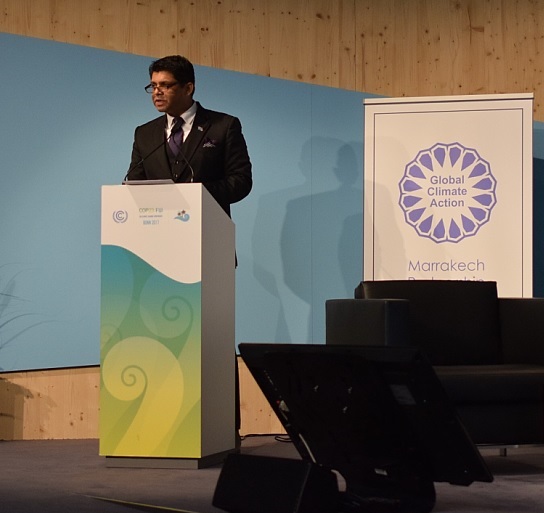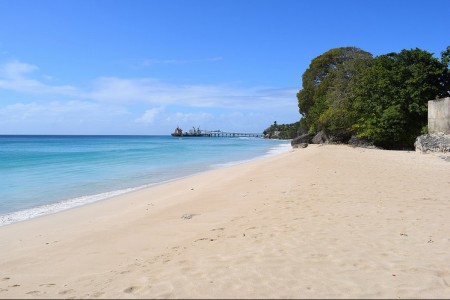How Small Islands Can Transition to Renewable Energy

spoke at a COP23 side event about identifying investment
opportunities for NDC implementation. (Credit: Annie Guo)
Small Island Developing States (SIDS) are on the front line of climate change, facing the damage of shrinking coastlines and the ravages of tropical storms. However, these 57 island nations around the world can attempt to address this global challenge by relying on their renewable resources including sunshine, wind, hydropower and biomass. The topic was the subject of multiple events in November at COP23 in Bonn, Germany.
A panel titled “Achieving 100% Renewable Power Supply for Small Island Developing States” concluded that 100-percent-renewable energy without variability is a possibility for many SIDS. The challenge is not finding the technology but securing the capital.
Countries around the world are embarking on a transition to renewable energy to tackle climate change, cut financial costs, spur economic growth, and reduce air pollution.
SIDS are uniquely positioned to benefit from a clean energy economy for three main reasons. First, it can reduce their heavy reliance on imported fossil fuels. Second, it can stimulate economic growth. Third, it can improve their resiliency during increasing storm events.
Oil imports account for more than 90 percent of the energy consumed by SIDS, making them incredibly vulnerable to frequent fluctuations in oil prices. In 2016 alone, oil prices fluctuated more than 200 percent. Investing in renewable energy would allow more predictability and enable these countries to strive for energy independence.
In some SIDS, oil imports can cost up to 20 percent of their GDPs. Reducing this economic drain can free up spending to be invested locally, increasing economic security. In many instances, renewable energy can outcompete fossil fuels on price. It will continue to do so as prices plummet. The International Renewable Energy Agency anticipates a decrease in solar costs of up to 65 percent by 2025.
Additionally, renewable energy is a key strategy for resiliency in the face of increasing tropical storms. While damage to a centralized power plant can leave an entire island without power, distributed energy, such as solar PV, can increase energy access.
This fact is an unfortunate reality for the citizens of Puerto Rico. Only 68 percent of the island’s power grid was online 10 weeks following Hurricane Maria. In addition, storm damage to seaports can halt the delivery of fuel, leaving an island stranded without energy.
Several islands have pledged to reach 100-percent-renewable energy. But the primary focus of discussion among the panelists at this event at COP23 was the example of a 100-percent-renewable-energy transition for Seychelles.
The Seychelles archipelago consists of 115 islands off the coast of East Africa. Their primary energy source is diesel fuel. Fuel imports account for 10 percent of their national annual budget, making them particularly vulnerable to volatility in oil prices.
Tony Imaduwa, CEO of the Seychelles Energy Commission, said the impetus for this transition is occurring for a few reasons. “Today we stand on the threshold of a new age of sustainable development. Our existence as independent nations is at risk. We have no other option but to kick our addiction to fossil fuels. Renewable energy provides us with this opportunity.”
According to Imaduwa, 90 percent of Seychelles’ greenhouse gas emissions (GHG) are derived from their fossil-fuel consumption. Therefore, decarbonizing their energy mix can slash their contribution to carbon pollution. Currently, Seychelles has committed to reduce emissions 21.4 percent by 2025 and 29 percent by 2030 – dependent on international support.
The report titled “100% Renewable Seychelles” identifies a scenario in which 100 percent of the electricity without variability can be generated for Seychelles’ most populous island. It would involve a combination of 50 MW wind power, 125 MW solar PV, 25 GWh of annual liquid biomass, and a pumped 1-GWh hydroelectric storage plant. This represents a daunting task considering that only 2.5 percent of the Seychelles national energy consumption is currently produced by renewable energy.
Additional research identified a roadmap for 100-percent-renewable energy without variability for Barbados as well. Olav Hohmeyer, professor at Europa-Universität Flensburg, explained his research showing that the addition of electric vehicles would reduce the overall costs for the entire whole system and could even allow Barbados to supply electricity to cruise ships.
Hohmeyer found that if Barbados had installed 100-percent-renewable energy in 2013, they would have reduced their electricity costs by 30 percent. For many SIDS, 100-percent-renewable energy would be cheaper than oil based on today’s price at $60.40 a barrel.
The report found numerous economic benefits for Seychelles, calculating that 100-percent-renewable energy compared to current average electricity rates would be 40 percent cheaper. Additionally, Seychelles’ largest island could save 650 million Seychellois Rupees annually – about $47 million dollars – on avoided fuel costs alone.
However, SIDS are still considered developing countries and with an average GDP of only $1.4 billion, the upfront financing of such infrastructure is nearly impossible. 100-percent-renewable energy for Seychelles is estimated to cost €270 million, translating to 10 percent higher costs than existing fuel costs for power production.
The question remains: how can this vision translate to action? Stefan Wehner, founding partner at the greenwerk, identified a number of policies and regulations that can achieve the level of financing needed. These include climate finance instruments such as grants, tariffs, loans, equity, insurances and/or guarantees.
Theodore Merguerite, principal policy analyst from the Ministry of Environment, Energy and Climate Change of Seychelles, discussed funding sources. These included climate grants from Global Environmental Finance, Green Climate Fund, and Africa Renewable Energy Initiative. They also included climate loans from multilateral development banks.
Financing might be available, but the panel acknowledged that accessing it is still a major hurdle. Roland Roesch, senior program officer at International Renewable Energy Agency (IRENA), said the intergovernmental organization’s “Lighthouse Initiative” is working to mobilize $500 million USD in funding for renewable-energy infrastructure for SIDS.
Roesch explained that applying for funding can often be burdensome. There are multiple application processes. Many island nations need assistance to navigate the financing process.
Despite acknowledging financial challenges, Hohmeyer concluded the presentation on an optimistic note. “Climate change mitigation will require all countries to go 100-percent-renewable-energy before 2050. Virtually every country can do it. All the technologies and all the know-how are already available. Don’t wait for the magic bullet. We have everything we need we just need to get going.”
Join our LinkedIn group to discuss this article. You may also email the author directly using our contact form.
